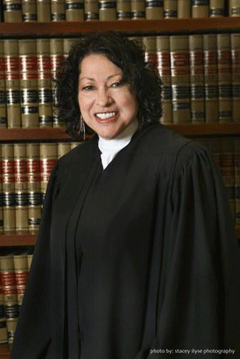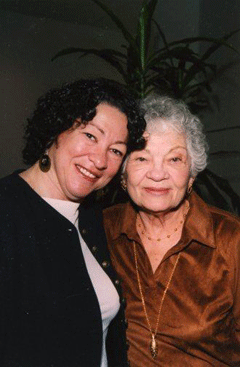How Green the New Supreme Court Nominee
Air Date: Week of May 29, 2009

Judge Sonia Sotomayor. (Courtesy of the White House)
Living On Earth's Ingrid Lobet takes a look at some of Judge Sonia Sotomayor's environmental decisions, and some elements that may shape her outlook on upcoming environmental questions before the Supreme Court.
Transcript
GELLERMAN: In choosing Judge Sonia Sotomayor for the nation's highest court, President Obama has selected a legal scholar with roots in Puerto Rican culture. Judge Sotomayor grew up in the New York City barrio of the Bronx and of course is a lifelong Yankees fan. She excelled at Princeton and Yale and has been a U.S District Court judge for 17 years. In that time she’s ruled on a number of environmental cases…and Living on Earth’s Ingrid Lobet looks at her decisions.

Judge Sotomayor’s ruling on power plants and aquatic life was a win for environmentalists. (Photo: Wigwam Jones)
LOBET: The best-known environmental decision by Judge Sotomayor is a case about power plants that are located along rivers and the damage they cause to aquatic life through their giant water intakes. In 2007, riverkeepers around the country challenged an Environmental Protection Agency rule on how power plants upgrade their intakes to protect fish. EPA had allowed plant operators to use cost-benefit analyses in making the equipment selection. In other words they could choose the less expensive of two technologies, even if that meant fewer fish would be saved.
Judge Sotomayor's opinion is seen as siding with environmentalists. She wrote that since the Clean Water Act requires the "best available technology" -- that doesn't leave room for a cost-benefit analysis.
Some legal scholars say she was reading the clear language of the law. But just a few weeks ago her decision was overturned by the Supreme Court, in an opinion by Justice Scalia who found nothing in the law that prohibits balancing benefit against cost.

Judge Sonia Sotomayor. (Courtesy of the White House)
Another opinion authored by Judge Sotomayor took a relatively unsympathetic view of a woman whose husband had worked aboard oil tanker ships, and died at the age of 39 from squamous cell skin cancer. The woman alleged his cancer was caused by exposure to benzene and hydrocarbons aboard ship. Sotomayor upheld the lower court that dismissed the suit.
Judge Sotomayor took part in a decision in 2005 that appears sympathetic to owners who lose their property through eminent domain for urban renewal. The panel of three judges said the Village of Port Chester, New York needed to do more to inform a property owner about public meetings and the appeals process for the taking of his property.
There are a number of influences that may have helped shape Judge Sotomayor.
Except for the periods she spent on the leafy campuses of Princeton and Yale, she's lived in urban New York, first in the Bronx, now in lower Manhattan.

Judge Sotomayor with her mother, Celina Sotomayor. (Courtesy of the White House)
Her mother worked as a nurse in a methadone clinic, which could give Judge Sotomayor a deep understanding of drug addiction. Heroin has been particularly devastating in the Puerto Rican community.
And as a lawyer in the Manhattan district attorney's office she prosecuted assault, robbery and police brutality cases. Then she went on to practice intellectual property law.
There's much attention to Sonia Sotomayor as a woman and a proud Nuyorican. But if she's confirmed her education and work experience are likely to be factors at least as strong in deciding environmental questions that might reach the supreme court in the coming years, such as whether a dry riverbed constitutes a river…or how to limit industrial emissions in the hope of preserving polar icecaps.
For Living On Earth, I'm Ingrid Lobet.
Living on Earth wants to hear from you!
Living on Earth
62 Calef Highway, Suite 212
Lee, NH 03861
Telephone: 617-287-4121
E-mail: comments@loe.org
Newsletter [Click here]
Donate to Living on Earth!
Living on Earth is an independent media program and relies entirely on contributions from listeners and institutions supporting public service. Please donate now to preserve an independent environmental voice.
NewsletterLiving on Earth offers a weekly delivery of the show's rundown to your mailbox. Sign up for our newsletter today!
 Sailors For The Sea: Be the change you want to sea.
Sailors For The Sea: Be the change you want to sea.
 The Grantham Foundation for the Protection of the Environment: Committed to protecting and improving the health of the global environment.
The Grantham Foundation for the Protection of the Environment: Committed to protecting and improving the health of the global environment.
 Contribute to Living on Earth and receive, as our gift to you, an archival print of one of Mark Seth Lender's extraordinary wildlife photographs. Follow the link to see Mark's current collection of photographs.
Contribute to Living on Earth and receive, as our gift to you, an archival print of one of Mark Seth Lender's extraordinary wildlife photographs. Follow the link to see Mark's current collection of photographs.
 Buy a signed copy of Mark Seth Lender's book Smeagull the Seagull & support Living on Earth
Buy a signed copy of Mark Seth Lender's book Smeagull the Seagull & support Living on Earth

